12 Popular Types of Magnolia Trees
Magnolia, a remarkably diverse genus of plants, is often regarded as a symbol of the South. It encompasses a wide variety of species that offer suitability for colder climates. Types of Magnolia trees are known for their beauty, featuring large leaves and stunning white or pink flowers that typically bloom in early spring. What sets magnolias apart is their ability to flower even before their leaves unfurl, creating a captivating sight. Depending on their specific growing conditions, magnolias can be either evergreen or deciduous. Some species take the form of multi-stemmed shrubs, while others stand as majestic, upright trees of substantial size. Interestingly, certain magnolia species demonstrate adaptability in their growth habits, adjusting to different climates and environmental factors. Notably, the blossoms of flowering magnolias are highly fragrant, further enhancing their allure. Although some types of magnolia trees are not known for their rapid growth, exercising patience will be duly rewarded with their exquisite beauty and charm.

Magnolia Tree Care
Types of Magnolia trees are relatively easy to cultivate and possess a distinctive ability to thrive in shady environments, setting them apart from other flowering trees and shrubs. However, if you intend to incorporate magnolia trees into your landscape, it is crucial to consider their preferred growing conditions. Optimal growth is achieved when magnolias are planted in well-drained soil, as they generally struggle in excessively moist or waterlogged areas. To promote the flourishing of magnolia trees, it is recommended to provide them with a springtime application of slow-release fertilizer, ensuring a steady and balanced nutrient supply.
Presented below are 12 prevalent species of Magnolia trees, which will assist you in identifying various types of Magnolias. Additionally, you will find fundamental guidelines on cultivating these magnificent trees.
1: Anise Magnolia (Magnolia Salicifolia)
- Native Area: Japan
- USDA Hardiness Zones: 6 to 9
- Height: Above to 30 feet
- Sun Exposure: Full sun to part shade
This is also one of the most beautiful types of Magnolia trees. The anise magnolia, scientifically known as Magnolia salicifolia or the willow-leaf magnolia, displays unique foliage reminiscent of willow trees or shrubs. Its leaves are wider than willow leaves but narrower compared to the typical magnolia leaf. This deciduous tree is particularly noteworthy for its exquisite white flowers adorned with slender, strap-like petals. The blossoms emerge before the leaves unfurl in the spring, creating a striking visual display. As the autumn season approaches, the anise magnolia graces the landscape with its captivating fall color, turning a pleasing golden yellow.

2: Bigleaf Magnolia (Magnolia Macrophylla)
- Native Area: Southeastern U.S, Mexico
- USDA Hardiness Zones: 5 to 8
- Height: 30 to 40 feet
- Sun Exposure: Full sun to part shade
One of the most eye-catching types of Magnolia trees. The Bigleaf magnolia, scientifically known as Magnolia macrophylla, truly lives up to its name with its remarkable foliage. Its leaves can reach impressive lengths of up to 32 inches, making them one of the largest among magnolia species. While it typically sheds its leaves in the fall, in warmer zones it may retain its foliage throughout the year, exhibiting evergreen characteristics. The captivating blooms of the Bigleaf magnolia emerge in May, showcasing their grandeur with flowers that can span up to 10 inches in diameter. The blossoms are characterized by their white coloration, accented by purple petal bases, creating a stunning contrast.
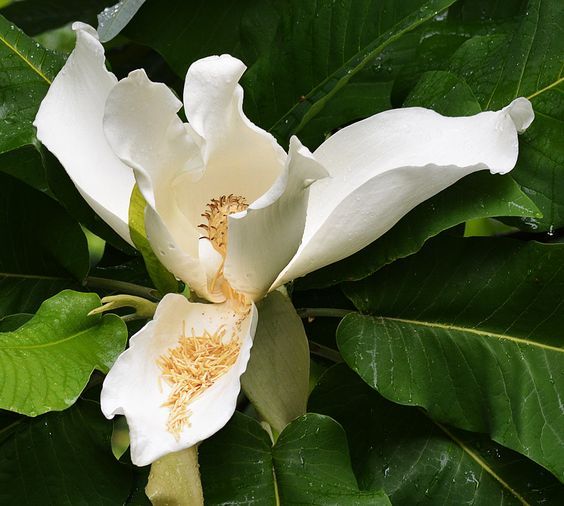
3: Cucumber Tree (Magnolia Acuminata)
- Native Area: Appalachian regions of U.S, Southern Ontario
- USDA Hardiness Zones: 3 to 8
- Height: 60 to 80 feet
- Sun Exposure: Full sun to part shade
The Cucumber tree magnolia, scientifically known as Magnolia acuminata, derives its name from the resemblance of its fruits to the vegetable. This particular magnolia species is renowned for its cold-hardiness, making it suitable for colder climates. While it shares characteristics with the classic southern magnolias, such as large glossy leaves that can reach up to 10 inches in length and a substantial growth habit, its greenish tulip-shaped flowers are less flamboyant, measuring only about 2 inches across. However, the fruits that develop after the flowers provide an intriguing transformation, transitioning from green to red as they mature. Despite its less showy blooms, the Cucumber tree magnolia serves as an excellent shade tree or specimen tree in colder regions, provided you are willing to embrace the occasional mess caused by its large leaves.
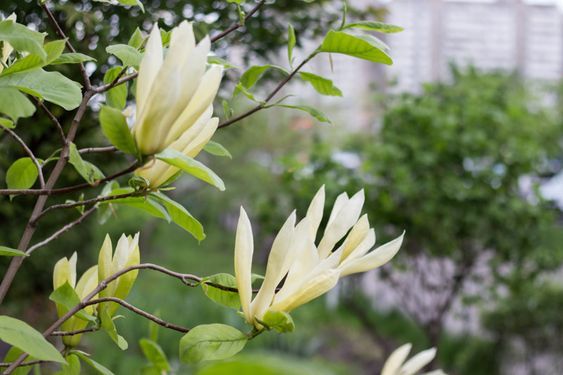
4: Ashe's Magnolia (Magnolia Ashei)
- Native Area: Florida
- USDA Hardiness Zones: 6 to 9
- Height: Up to 30 feet
- Sun Exposure: Full sun to part shade
Ashe’s magnolia, scientifically known as Magnolia ashei, is a versatile plant that can be cultivated as either a sizable shrub or a compact tree, depending on pruning techniques. This magnolia species is occasionally regarded as a subspecies of the bigleaf magnolia, with its impressive leaves reaching lengths of up to 2 feet. The name “Ashe’s magnolia” pays homage to William Willard Ashe, a distinguished figure associated with the United States Forest Service. In the spring, after the emergence of light-green leaves, this magnolia species produces exquisite white flowers with petals that can span up to 1 foot in length.
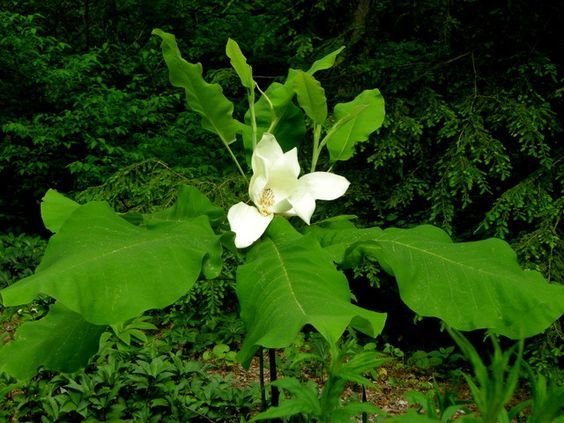
5: Lily Magnolia (Magnolia Liliiflora)
- Native Area: Southwest China
- USDA Hardiness Zones: 7 to 10
- Height: 8 to 12 feet
- Sun Exposure: Full sun to part shade
The lily magnolia, scientifically known as Magnolia liliflora, is a charming species that typically grows as a compact shrub or small tree. It is known for its striking display of flowers in early spring, before the leaves unfurl. During this time, the shrub showcases a profusion of large, lightly perfumed blossoms in hues of reddish-purple or pink, resembling the shape of lilies. One particularly popular cultivar, ‘Nigra’, stands out for its deeply colored flowers. Following the flowering period, dark green elliptical leaves emerge, adding to the overall beauty of the plant. It is worth noting that the lily magnolia serves as a parent species for the well-known saucer magnolia.

6: Kobus Magnolia (Magnolia Kubos)
- Native Area: Japan, Korea
- USDA Hardiness Zones: 5 to 8
- Height: 25 to 50 feet, occasionally 75 feet with very old trees
- Sun Exposure: Full sun to part shade
The Kobus magnolia, scientifically known as Magnolia kobus, is a slow-growing species that embodies the quintessential characteristics of magnolias. It boasts fragrant white flowers delicately tinged with pink, which bloom before the leaves unfurl, creating a captivating display. Complementing the stunning flowers are its large, dark-green leaves, adding to its overall allure. Also referred to as the Japanese magnolia or northern Japanese magnolia, it is commonly chosen as a specimen tree when early-season flowers are desired. While the Kobus magnolia tends to develop multiple trunks, shaping it by pruning back to a central leader can achieve a more traditional tree-like form.
It’s noteworthy that the Kobus magnolia is one of the parent species, alongside the Stella magnolia,responsible for producing the Loebner magnolia. These parent species contribute their unique traits to the hybrid, resulting in the distinct characteristics and beauty exhibited by the Loebner magnolia.
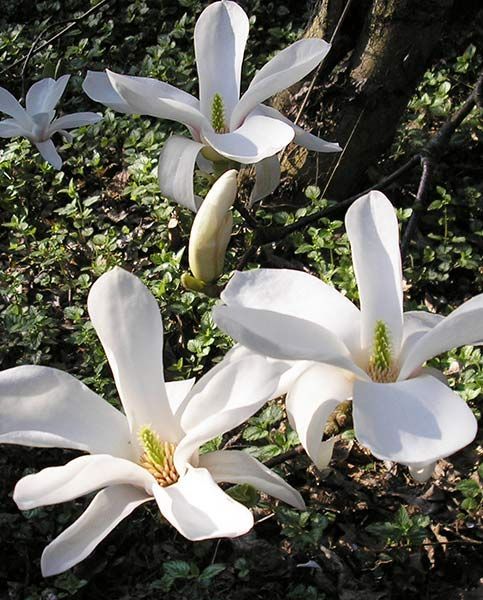
7: Loebner Magnolia (Magnolia Loebneri)
- Native Area: hybrid plant; no natural range
- USDA Hardiness Zones: 5 to 9
- Height: 20 to 30 feet; occasionally as tall as 60 feet
- Sun Exposure: Full sun to part shade
The Loebner magnolia, derived from a cross between the Kobus magnolia and the star magnolia, is a captivating hybrid. This small tree typically develops multiple stems, but with strategic pruning, it can be shaped to have a central leader. Its noteworthy feature is the profusion of fragrant star-shaped flowers in hues of pink and white, measuring approximately 4 to 6 inches in width. These exquisite blooms grace the tree in early spring, enchanting observers before the foliage emerges. The dark green oval leaves, reaching a maximum length of 5 inches, contribute to the tree’s overall charm and complement the stunning floral display.
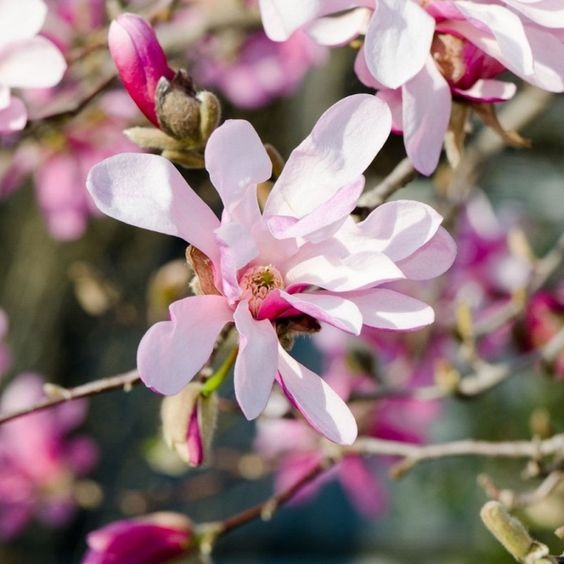
8: Saucer Magnolia (Magnolia Soulangiana)
- Native Area: hybrid plant; no natural range
- USDA Hardiness Zones: 4 to 9
- Height: 20 to 25 feet
- Sun Exposure: Full sun to part shade
The saucer magnolia, a result of crossing the lily magnolia and the Yulan magnolia, showcases a delightful blend of characteristics. This versatile plant can either take the form of a large multi-stemmed shrub or a compact tree. Its iconic white flowers, adorned with captivating pink interiors, grace the landscape in early spring, preceding the emergence of leaves. The saucer magnolia boasts a wide range of cultivars, offering diverse flower colors within the purple spectrum. Renowned for its beauty and adaptability, it is the most commonly cultivated magnolia species in the United States, captivating gardeners across the nation.
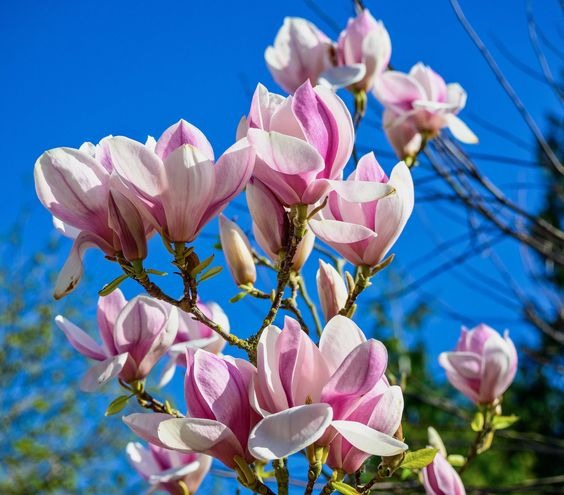
9: Southern Magnolia (Magnolia Grandiflora)
- Native Area: Southeastern U.S.
- USDA Hardiness Zones: 7 to 9
- Height: 60 to 80 feet
- Sun Exposure: Full sun to part shade
When magnolias are mentioned, especially in the context of the antebellum South or depicted in literary works, it is often the majestic southern magnolia that captures the imagination. This iconic magnolia tree holds the honor of being the state flower of Louisiana and Mississippi. Known for its grandeur, the southern magnolia is a large evergreen tree that demands ample space to thrive. Its elliptical leaves, sizable and leathery, can reach lengths of up to 10 inches. One of the remarkable features of this magnolia is its white flowers, which unfurl from mid-summer to early autumn and can span an impressive 12 inches in diameter. While most magnolias favor full sun but tolerate some shade, the southern magnolia actually flourishes best in partial shade, showcasing its adaptability and unique preferences in the world of magnolias.
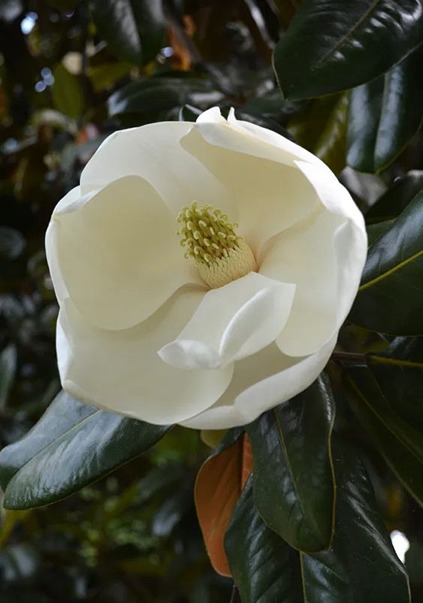
10: Star Magnolia (Magnolia Stellata)
- Native Area: Japan
- USDA Hardiness Zones: 4 to 8
- Height: 15 to 20 feet
- Sun Exposure: Full sun to part shade
The star magnolia, a delightful deciduous small tree or large shrub, graces gardens with its early blooms. In late winter or early spring, before the arrival of other flowering trees and even most spring bulbs, this magnolia unveils its exquisite star-shaped white flowers. It is truly a sight to behold. To ensure its optimal blooming in spring, it is advisable to select a sheltered spot for planting, as the delicate buds of the star magnolia are susceptible to frost damage. By providing a protective environment, you can savor the beauty of its early blossoms and enjoy the magnolia’s enchanting presence in your garden.
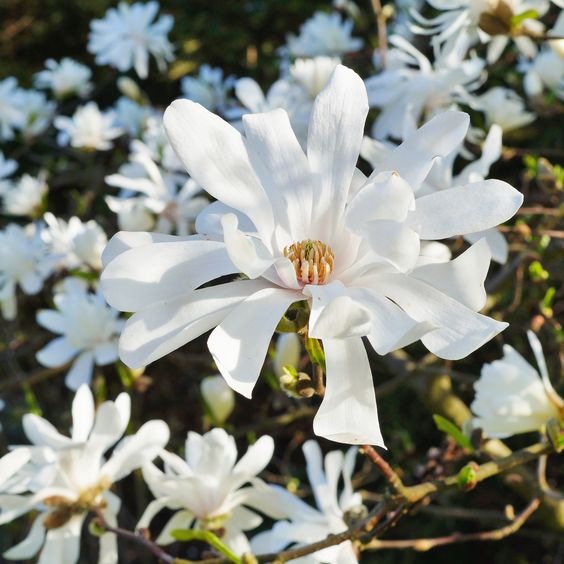
11: SweetBay Magnolia (Magnolia Virginiana)
- Native Area: Eastern U.S.
- USDA Hardiness Zones: 5 to 10
- Height: 10 to 35 feet
- Sun Exposure: Full sun to part shade
The sweetbay magnolia, known by various regional names such as beaver tree, swamp magnolia, or laurel magnolia, adapts to different climates and environments. In cooler regions, it typically takes the form of a deciduous shrub with multiple stems. However, in warmer zones, it transforms into an upright evergreen tree. This versatile plant thrives in wet or boggy areas, making it an ideal choice for gardens with clay soils or marshy conditions. In midsummer to early autumn, the sweetbay magnolia displays its charm with waxy white flowers that captivate the senses. Its glossy green oblong leaves, adorned with silvery undersides, add an elegant touch to its overall appearance. Whether as a shrub or a tree, the sweetbay magnolia graces landscapes with its adaptability and striking features, making it a valuable addition to any garden.
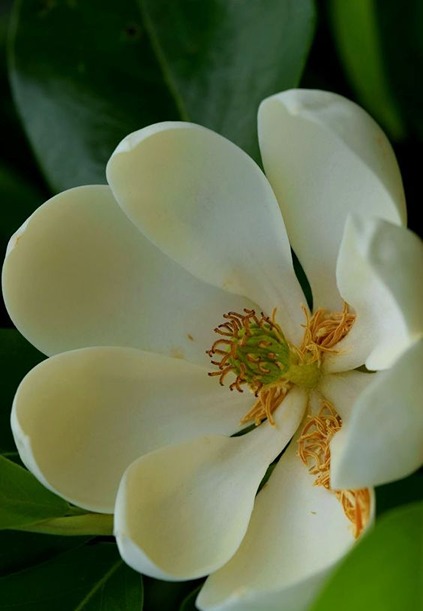
12: Umbrella Magnolia (Magnolia Tripetala)
- Native Area: Eastern North America
- USDA Hardiness Zones: 5 to 8
- Height: 15 to 30 feet
- Sun Exposure: Full sun to part shade
The umbrella magnolia, aptly named for its striking features, showcases enormous shiny leaves that can reach up to 24 inches in length and 10 inches in width. These impressive leaves gracefully droop down around the ends of the branches, creating a distinctive umbrella-like effect. As a multi-stemmed small tree, it thrives in its native habitat of the understory forests of Appalachia, making it exceptionally well-suited for shady locations.
In late spring to early summer, the umbrella magnolia puts on a stunning display with its creamy white flowers. These flowers, measuring between 6 to 10 inches in diameter, emerge shortly after the leaves have unfurled. While they possess a delightful fragrance, it is worth noting that their scent is not particularly sweet.
With its remarkable foliage and elegant blooms, the umbrella magnolia adds a touch of grandeur and beauty to any landscape. Its ability to thrive in shaded areas and its unique aesthetic qualities make it a prized choice for gardeners seeking a captivating and resilient tree.
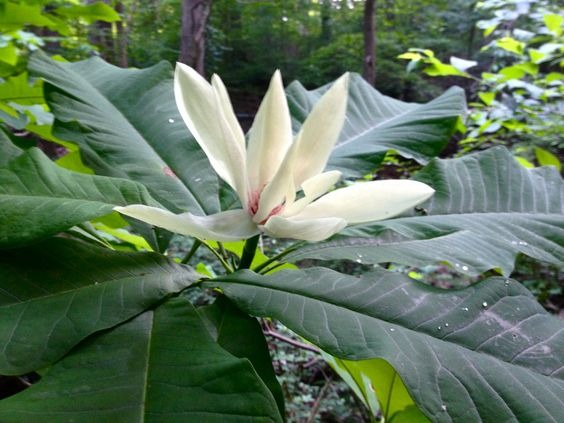
Magnolia Care and Fungal Disease Prevention
Magnolias, although beloved for their beauty, are particularly vulnerable to fungal diseases, often presenting as different types of leaf spots. These diseases tend to prevail in environments characterized by excessive moisture, shade, and humidity, making trees and shrubs in such conditions more susceptible. To safeguard against fungal diseases, it is crucial to implement proper care practices.
Regular and thorough pruning plays a crucial role in preventing fungal infections. By diligently removing any diseased or damaged branches, you can effectively reduce the risk of disease spread. Additionally, proactive measures such as applying preventive sprays of fungicide can provide an extra layer of protection. These sprays help to deter fungal growth and maintain the overall health of the magnolia.
Promoting adequate air circulation through careful pruning is another essential strategy to ward off fungal problems. By selectively removing branches and foliage that restrict airflow, you can create an environment less conducive to fungal infestations. This allows for better ventilation and reduces the likelihood of moisture buildup, which is often a contributing factor to fungal diseases.
By adopting these preventive measures and staying vigilant in monitoring the health of your magnolia, you can minimize the impact of fungal diseases and help ensure the longevity and vitality of your beloved tree or shrub.




